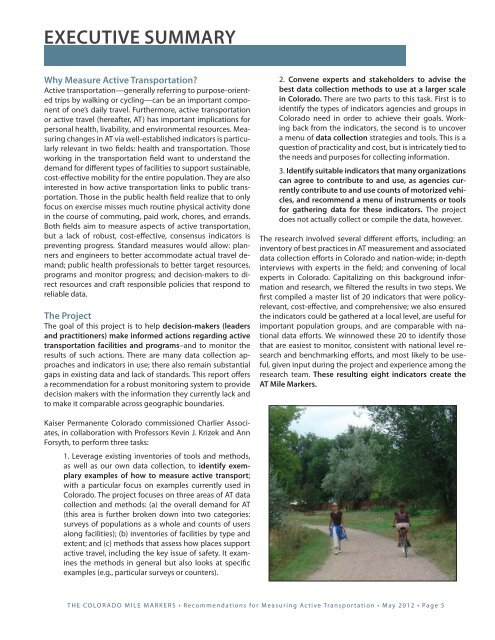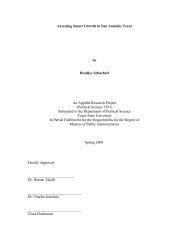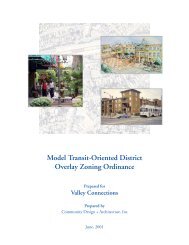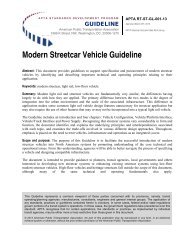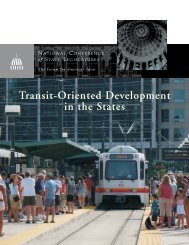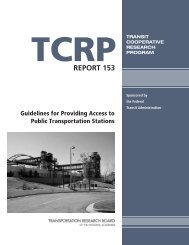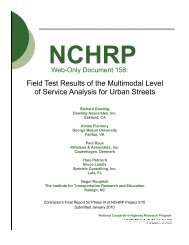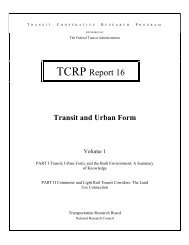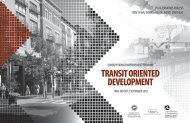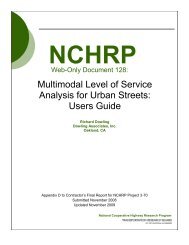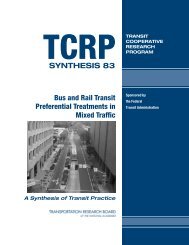the colorado mile markers: recommendations for measuring ...
the colorado mile markers: recommendations for measuring ...
the colorado mile markers: recommendations for measuring ...
Create successful ePaper yourself
Turn your PDF publications into a flip-book with our unique Google optimized e-Paper software.
Executive Summary<br />
Why Measure Active Transportation<br />
Active transportation—generally referring to purpose-oriented<br />
trips by walking or cycling—can be an important component<br />
of one’s daily travel. Fur<strong>the</strong>rmore, active transportation<br />
or active travel (hereafter, AT) has important implications <strong>for</strong><br />
personal health, livability, and environmental resources. Measuring<br />
changes in AT via well-established indicators is particularly<br />
relevant in two fields: health and transportation. Those<br />
working in <strong>the</strong> transportation field want to understand <strong>the</strong><br />
demand <strong>for</strong> different types of facilities to support sustainable,<br />
cost-effective mobility <strong>for</strong> <strong>the</strong> entire population. They are also<br />
interested in how active transportation links to public transportation.<br />
Those in <strong>the</strong> public health field realize that to only<br />
focus on exercise misses much routine physical activity done<br />
in <strong>the</strong> course of commuting, paid work, chores, and errands.<br />
Both fields aim to measure aspects of active transportation,<br />
but a lack of robust, cost-effective, consensus indicators is<br />
preventing progress. Standard measures would allow: planners<br />
and engineers to better accommodate actual travel demand;<br />
public health professionals to better target resources,<br />
programs and monitor progress; and decision-makers to direct<br />
resources and craft responsible policies that respond to<br />
reliable data.<br />
The Project<br />
The goal of this project is to help decision-makers (leaders<br />
and practitioners) make in<strong>for</strong>med actions regarding active<br />
transportation facilities and programs–and to monitor <strong>the</strong><br />
results of such actions. There are many data collection approaches<br />
and indicators in use; <strong>the</strong>re also remain substantial<br />
gaps in existing data and lack of standards. This report offers<br />
a recommendation <strong>for</strong> a robust monitoring system to provide<br />
decision makers with <strong>the</strong> in<strong>for</strong>mation <strong>the</strong>y currently lack and<br />
to make it comparable across geographic boundaries.<br />
2. Convene experts and stakeholders to advise <strong>the</strong><br />
best data collection methods to use at a larger scale<br />
in Colorado. There are two parts to this task. First is to<br />
identify <strong>the</strong> types of indicators agencies and groups in<br />
Colorado need in order to achieve <strong>the</strong>ir goals. Working<br />
back from <strong>the</strong> indicators, <strong>the</strong> second is to uncover<br />
a menu of data collection strategies and tools. This is a<br />
question of practicality and cost, but is intricately tied to<br />
<strong>the</strong> needs and purposes <strong>for</strong> collecting in<strong>for</strong>mation.<br />
3. Identify suitable indicators that many organizations<br />
can agree to contribute to and use, as agencies currently<br />
contribute to and use counts of motorized vehicles,<br />
and recommend a menu of instruments or tools<br />
<strong>for</strong> ga<strong>the</strong>ring data <strong>for</strong> <strong>the</strong>se indicators. The project<br />
does not actually collect or compile <strong>the</strong> data, however.<br />
The research involved several different ef<strong>for</strong>ts, including: an<br />
inventory of best practices in AT measurement and associated<br />
data collection ef<strong>for</strong>ts in Colorado and nation-wide; in-depth<br />
interviews with experts in <strong>the</strong> field; and convening of local<br />
experts in Colorado. Capitalizing on this background in<strong>for</strong>mation<br />
and research, we filtered <strong>the</strong> results in two steps. We<br />
first compiled a master list of 20 indicators that were policyrelevant,<br />
cost-effective, and comprehensive; we also ensured<br />
<strong>the</strong> indicators could be ga<strong>the</strong>red at a local level, are useful <strong>for</strong><br />
important population groups, and are comparable with national<br />
data ef<strong>for</strong>ts. We winnowed <strong>the</strong>se 20 to identify those<br />
that are easiest to monitor, consistent with national level research<br />
and benchmarking ef<strong>for</strong>ts, and most likely to be useful,<br />
given input during <strong>the</strong> project and experience among <strong>the</strong><br />
research team. These resulting eight indicators create <strong>the</strong><br />
AT Mile Markers.<br />
Kaiser Permanente Colorado commissioned Charlier Associates,<br />
in collaboration with Professors Kevin J. Krizek and Ann<br />
Forsyth, to per<strong>for</strong>m three tasks:<br />
1. Leverage existing inventories of tools and methods,<br />
as well as our own data collection, to identify exemplary<br />
examples of how to measure active transport;<br />
with a particular focus on examples currently used in<br />
Colorado. The project focuses on three areas of AT data<br />
collection and methods: (a) <strong>the</strong> overall demand <strong>for</strong> AT<br />
(this area is fur<strong>the</strong>r broken down into two categories:<br />
surveys of populations as a whole and counts of users<br />
along facilities); (b) inventories of facilities by type and<br />
extent; and (c) methods that assess how places support<br />
active travel, including <strong>the</strong> key issue of safety. It examines<br />
<strong>the</strong> methods in general but also looks at specific<br />
examples (e.g., particular surveys or counters).<br />
The Colorado Mile Markers • Recommendations <strong>for</strong> Measuring Active Transportation • May 2012 • Page 5


